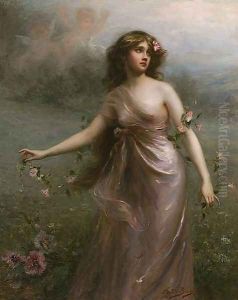Eduoard Bisson Paintings
Edouard Bisson was a French painter born on September 15, 1856, in Paris, France. He is best known for his romantic and allegorical paintings which often featured beautiful women in ethereal settings. Bisson's works were characteristic of the Academic art style of the late 19th century, which emphasized traditional forms and techniques.
Bisson studied at the École des Beaux-Arts in Paris under influential painters such as Alexandre Cabanel, a prominent French academic artist known for his classical and mythological subjects. Bisson's education in this environment deeply influenced his style and thematic choices.
During his career, Bisson gained recognition for his art, particularly for his depictions of female beauty, and he exhibited at the Paris Salon, an official art exhibition of the Académie des Beaux-Arts in Paris. His paintings often portrayed women in dreamlike scenes that combined elements of nature with a sense of idealized beauty, which was in line with the tastes of the period. His work was well-received, and he was awarded medals at the Salons he participated in.
Bisson's art was part of the larger trend of Academic art which was prevalent in France before the Impressionist movement began to take hold. Although his work was popular during his lifetime, as the 20th century progressed and tastes shifted towards modernism, the popularity of Academic art waned. However, Bisson's contribution to the art world during his time was significant, and his paintings still hold historical value as examples of the aesthetic ideals of his era.
Edouard Bisson's paintings can be found in various private collections and museums. He continued to paint throughout his life until his death in 1939, just before the outbreak of World War II. His passing marked the end of an era, as the world was changing rapidly and the art world was moving increasingly away from the styles and traditions that Bisson represented.
